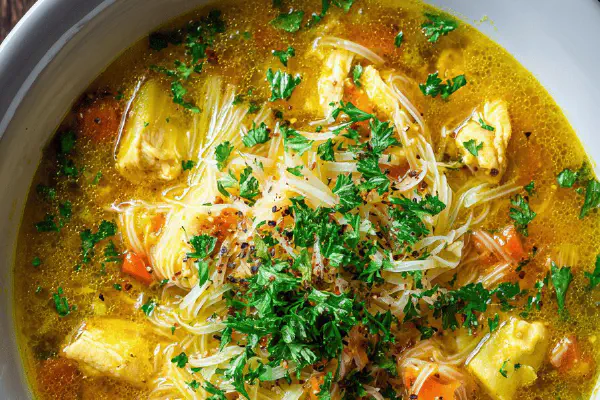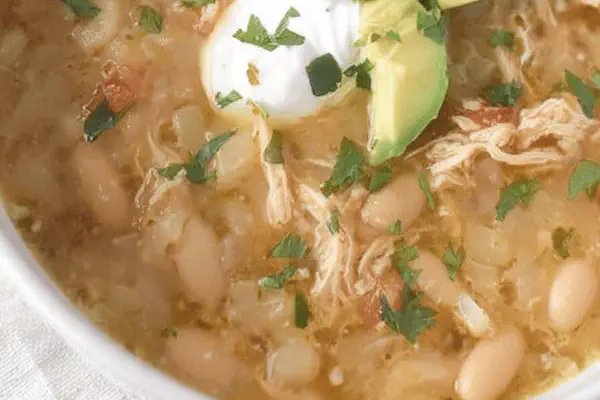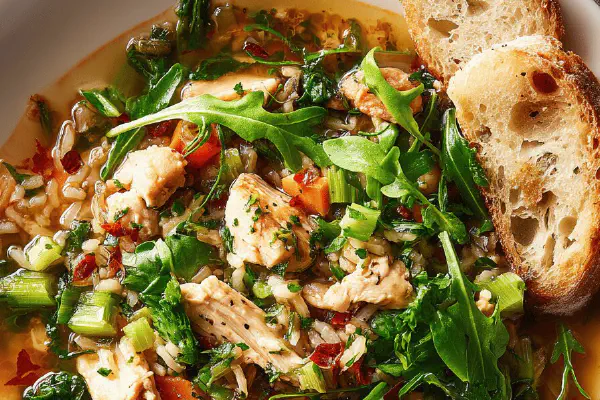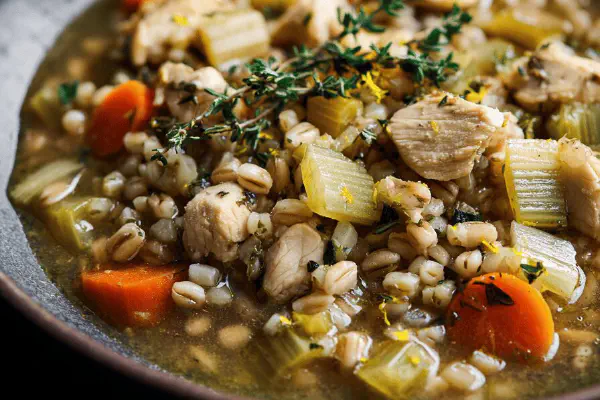Rustic Chicken Noodle Soup

By Emma
Certified Culinary Professional
Ingredients
Broth
- 900 g chicken carcass (approx 2 lb)
- 3.8 litres (about 15 cups) cold water
- 8 ml (1 ¾ tsp) ground turmeric
- 7 ml (1 ½ tsp) olive oil
- 1 medium onion, unpeeled, rinsed, roughly chopped
- 2 celery stalks, cut into chunks
- 2 medium carrots, unpeeled, chopped
- 1 leek, white and light green parts only, chopped
- 2 small cloves garlic, unpeeled, crushed
- 2 dried bay leaves
- 12 ml (2 ½ tsp) kosher salt
- 2 ml (½ tsp) cracked black peppercorns
- Handful of fresh parsley stems
Garnish
- 20 ml (1 ¼ tbsp) chopped fresh flat-leaf parsley
- 65 g (about ½ cup) broken wheat vermicelli noodles
About the ingredients
Method
Broth
- 1. Carcass submerged in cold water, slowly bring to boil over medium heat. Watch closely; as soon as bubbles rise steadily, skim the foam and scum with a fine mesh skimmer or ladle. Patience here; this clarifies broth better and avoids bitterness. Usually 5–7 minutes depending on heat source.
- 2. Mix turmeric with olive oil in small bowl till smooth paste. Swirl into broth—oil helps turmeric disperse evenly so no clumps. Turmeric adds earthiness and vibrant color rather than heat.
- 3. Dump onions, celery, carrots, leeks, crushed garlic, bay leaves, salt, peppercorns, and cilantro stems in. Reduce to the lowest simmer—the broth should barely bubble. Cover partially, leave lid ajar to let some steam escape but retain heat. You want a gentle cooking, not a boil that turns cloudy broth.
- 4. Let simmer for about 2 hours 15 minutes. Check veggies: carrots should start softening but hold shape; broth will deepen in color and smell fragrant with turmeric and aromatics. No hurry. If impatient, risk greasy or unfinished flavors.
- 5. Set up a fine sieve lined with cheesecloth or multiple layers of paper towel over a large clean pot. Pour broth slowly, filtering out solids. Press gently if you want maximum flavor, but no squeezing hard to avoid cloudiness from broken veggies.
- 6. Broth must cool before skimming fat. Transfer pot into a cold water bath or fridge for 2 hours. Fat congeals on surface. Scrap off with spoon or paper towel. If rushed, line sieve with thick paper towels and filter hot broth slowly to trap fat. I prefer chilling; clearer broth every time.
- 7. Pick all remaining meat off carcass—reserve. Discard bones, aromatics.
Garnish
- 8. Return skimmed broth to stove; bring back to boil over medium heat. Add chopped parsley, then broken vermicelli noodles. They cook fast; watch their texture closely. 3–6 minutes usually. Noodles should be tender but still with bite, not mushy.
- 9. Stir in approx 230 ml (1 cup) shredded cooked chicken. Heat just enough to warm chicken through. Overheating dries the meat and clouds broth.
- 10. Serve hot. Adjust salt and pepper if needed—taste important here. If too salty, a splash of water helps.
- Hints: Ginger chunk can replace garlic for gentle sharpness without overwhelming. Olive oil lends richness compared to vegetable oil's neutrality. Parsley can be swapped for cilantro or basil for herbal twist.
- Storage tip: Broth freezes well in portions. Noodles will get soggy so add fresh at serving. Chicken meat keeps for 2 days refrigerated.
Cooking tips
Chef's notes
- 💡 Start carcass cold in water—slow pull flavor, no rushed boil else cloudy, bitter. Skim foam just as bubbles rise steady. Foam = impurities, removing it means a clean broth. Patience. Use fine skimmer, avoid stirring once simmering starts. Heat low, barely bubbles. Don’t seal lid tight; lid ajar traps heat, lets some steam escape—no aggressive rolling boil.
- 💡 Mix turmeric with olive oil first in bowl—that stops clumping, helps even spread in broth. Left dry turmeric dumps color unevenly, gritty splotches. Olive oil lends fruit notes too. Can swap vegetable oil but less fragrant. Butter adds richness but can cloud. Ginger chunk replaces garlic for sharper but less pungent flavor, less biting; keeps broth clearer, digestive aid too.
- 💡 Veggies unpeeled add depth via skins—onion especially. Chop roughly, drop in whole or chunked. Bay leaves whole, never crushed—crushing brings bitterness. Low simmer 2+ hours breaks down aromas but keeps broth translucent. Check carrots for slight softening not mushy. Herbs stalks (parsley/cilantro) for subtle base notes, not overpowering.
- 💡 Strain broth through fine sieve lined with cheesecloth or layered paper towels. Press gently for max flavor but no squeezing—squeeze = veggie particles in broth = cloudiness. Chill broth fully before removing fat—fat congeals, scoop easily. Rushing, trap fat by filtering hot broth through thick towel layers but result differs. Learned chilling is best step. Clear broth has no oily sheen.
- 💡 Add vermicelli last; broken small to avoid giant clumps. Cook 3–6 minutes max. Watch noodle texture carefully—soft but still firm to bite, no mush or pasty. Fold shredded cooked chicken in last, just warm through. Overheat = dry meat, cloudy broth. Adjust salt and pepper final step—taste always shifts after simmering noodles and meat mixed in.
Common questions
Why skim foam early?
Impurities, blood clots settle first boil. Removes off-flavors, prevents murky broth. Skip this and broth cloudy, bitter taste rises quickly. Foam means proteins denature, get cooked out. Stirring stirs them back up, cloudiness starts.
Can I swap garlic with ginger chunk?
Absolutely. Ginger gives warmth without strong pungency. Garlic strong, can cloud broth, ginger less so. If no ginger, skip garlic, or use mild shallots instead. Each twist changes broth character; ginger is easier on digestion, subtle aroma boosts.
Soup too cloudy?
Most times means boiled too hard or skim missed early. Also pressing solids during strain crushes bits into broth. Fix by lower heat, skim often. Chill broth and remove fat after. Filter through fine cloth multiple times helps if still murky. Patience key.
How to store leftovers?
Broth freezes well standalone. Noodles soggy if frozen combined. Store noodles separately in fridge; add fresh when reheating broth. Chicken meat stays 2 days refrigerated. For longer, freeze broth in portioned containers. Reheat gently to avoid drying chicken, clouding broth.



